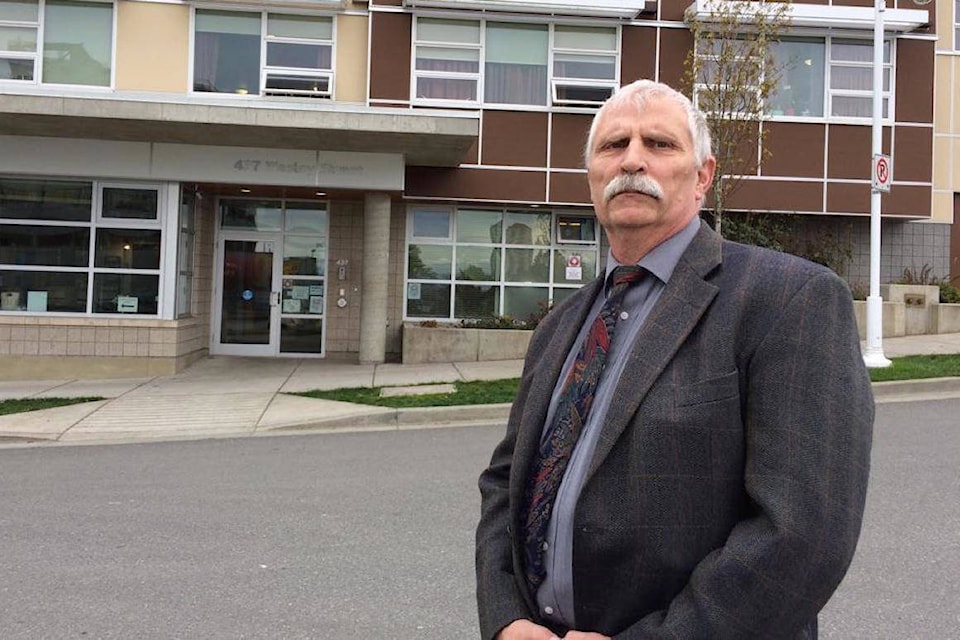Island Health will take a second swing at political support for a permanent supervised consumption site on Wesley Street.
Dr. Paul Hasselback, Island Health’s medical health officer for Central Vancouver Island, said the process for an application has been re-started and Island Health plans to go back to council in late October or November about re-zoning for a supervised consumption site.
The health authority needs council approval to rezone 437 Wesley St., a low-barrier apartment building that’s hosted a provincially mandated and more temporary overdose prevention site since February. But the community hasn’t been convinced about a permanent service.
At a public hearing in May, nearly all of the people who spoke about the rezoning bylaw were opposed, arguing crime and other problems stemming from drug use are already increasingly visible in the neighbourhood. Councillors voted against the third reading of the bylaw.
- RELATED: Community isn’t sold on safe-consumption site
Island Health has since looked at alternative models, but Hasselback said the health authority has not come up with anything better, and a supervised consumption site is still considered important.
Nanaimo’s overdose prevention site, where people can use drugs under supervision, was visited 4,373 times as of Sept. 3, with 146 different people accessing the service. There was 43 overdoses, including by 28 people who were at the site and 15 who were brought there.
The site is seen as one response to the overdose crisis and a step toward treatment, said Hasselback, who added that many people that use on an ongoing basis distrust the system and the communities that have alienated them.
“We actually have to start with where they are and rebuild that trust and rebuild a relationship with them in order to provide the opportunity for engagement and treatment,” said Hasselback.
A more permanent safe consumption site requires an application to Health Canada and has the potential to provide more appropriate space, more supportive care services, a better link to treatment and support services and potentially other forms of consumption because currently only injection is accommodated at the site, according to Hasselback, who considers it all an improvement in engaging users and preventing overdose deaths.
“Overdose prevention sites are predominantly structured to prevent death as an outcome. Until a permanent location is zoned for, irrespective of the location, then these additional supports are not formalized,” he said.
Coun. Ian Thorpe, among five councillors previously opposed to zoning changes that would allow a permanent supervised consumption site, told the News Bulletin he’s not opposed to a safe injection site and thinks it’s needed and he was supportive of Wesley Street on a temporary, emergency basis. But he said he’s certainly heard loud and clear the concerns of the neighbourhood about making it a permanent location and he’s interested to hear what Island Health has to say about whether there are other options and what those might look like.
Coun. Gord Fuller said he wants to see the service in more than one location, like in walk-in clinics and other supportive housing complexes.
“Do you think the guy off of Dover Bay is going to hop in his car and come down to Nanaimo to use, the recreational user? No.” said Fuller, who envisions a taxi-like service where volunteers would go to the drug user.
“I don’t think that’s been looked at.”
Sydney Robertson, who lives in south Nanaimo and spoke to the permanent site at the public hearing, said it’s great that there have been supports from the city, like security downtown and cleanup, but it’s not enough.
“That’s not all the fault of the safe consumption site. It still comes back to me of the issue of concentration of services in one small area of our city,” said Robertson.
She wants to see more services that address concerns and interests of residents and businesses close by and more concrete strategies to promote decentralization.
The B.C. Coroners Service has reported that 24 people have died of overdoses in Nanaimo between Jan.1-July 31, with fentanyl was detected in almost nine out of 10 of those deaths. Twenty-eight people died in 2016.
news@nanaimobulletin.com
Like us on Facebook and follow us on Twitter
